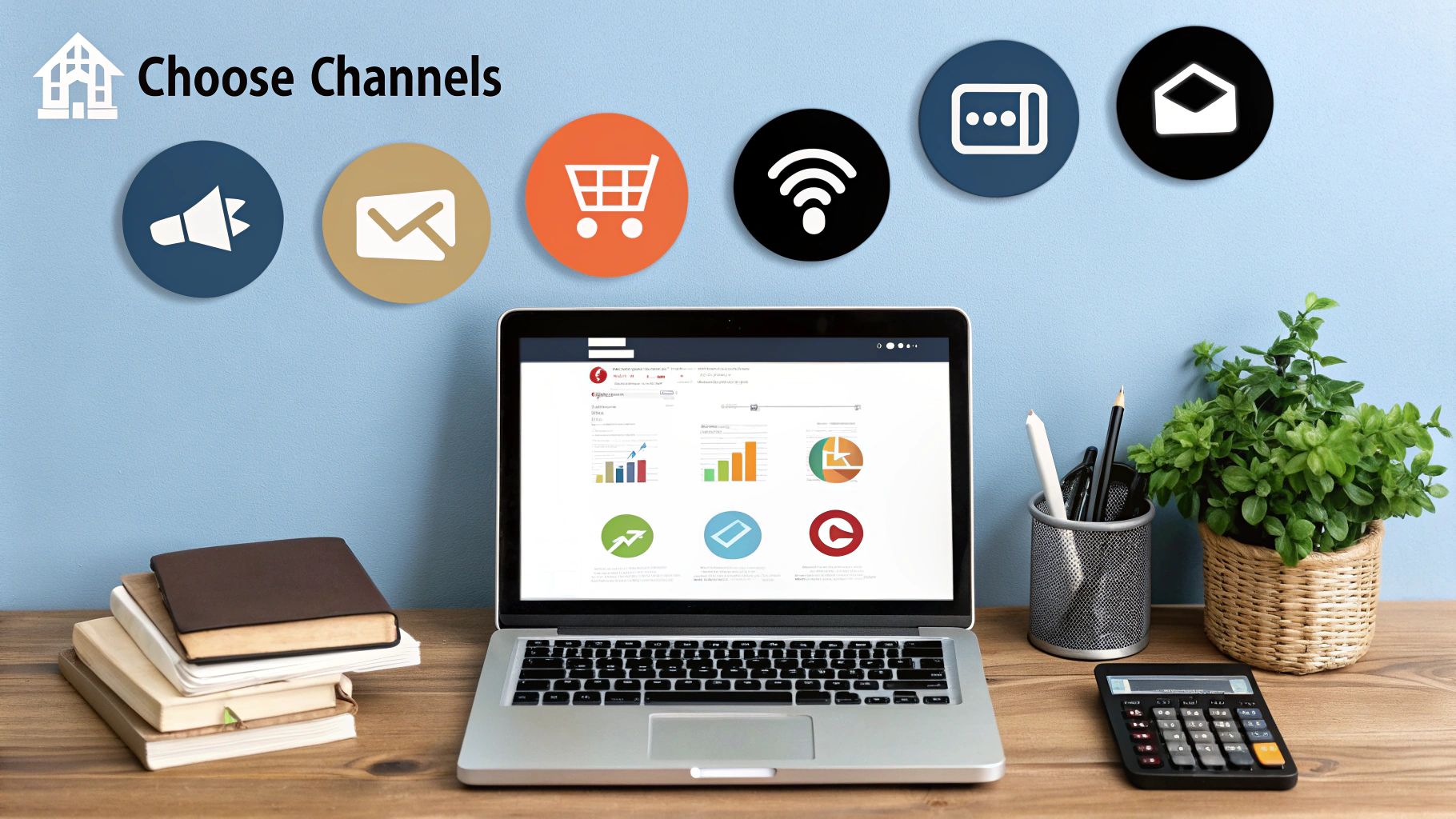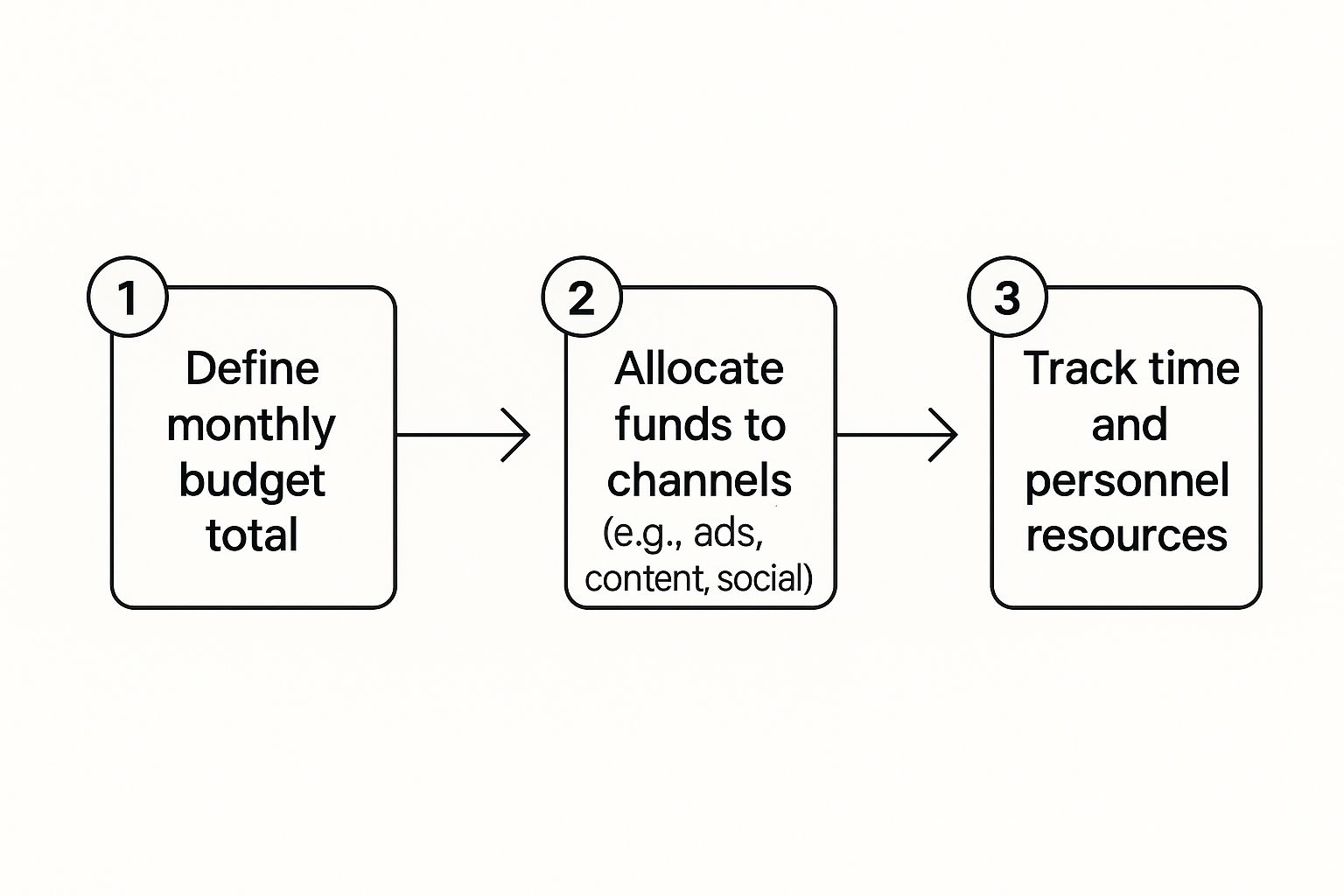A solid digital marketing strategy is your business's roadmap, guiding every decision you make. It all starts with understanding how to find product-market fit. Without that fundamental clarity, your marketing efforts—like blog posts, social media updates, and ad campaigns—are just shots in the dark, hoping to hit a target you can't even see.
Why a Marketing Strategy Is Your Business GPS

Think about it like this: running marketing campaigns without a strategy is like setting sail without a map. Sure, you might float around and stumble upon a few small islands of success, but you'll never reach your real destination efficiently. A well-defined plan turns those random actions into a focused, coordinated push, ensuring every ad, email, and piece of content works together toward a single, unified purpose.
This guide is designed to be that map. We’re going to break down exactly how to build a powerful plan from the ground up, starting with your big-picture goals and drilling down into the specific tactics needed to get you there. The point isn’t to create some stuffy, rigid document but a living, breathing blueprint that can adapt as your business grows.
Before we dive deep into the "how-to," let's get a high-level view of the key pillars we'll be covering. Each one is a critical piece of the puzzle.
Core Components of a Digital Marketing Strategy
| Component | Core Question It Answers |
|---|---|
| Audience Definition | Who are we actually trying to talk to? |
| Clear Objectives | What, specifically, are we trying to achieve? |
| Channel Selection | Where do our ideal customers hang out online? |
| Budget & Resources | What can we realistically spend in time and money? |
| Measurement (KPIs) | How will we know if any of this is actually working? |
Getting these components right is what separates the businesses that thrive from those that just get by.
The Foundation of Growth
A strong strategy is built on these core pillars, and they all have to work in harmony. If you neglect one, the whole structure starts to feel wobbly. Think of it as a stool—kick one leg out, and the whole thing comes crashing down.
This kind of structured thinking is more important than ever. Competition is fierce, and the stakes are high. Consider this: the global digital ad market is on track to hit a staggering $843 billion by 2025. On top of that, more than 50% of company marketing budgets are now poured into digital channels. With that much money on the line, you can't afford to just "wing it." You need a clear plan to make sure every dollar you spend delivers a real return.
Ultimately, this framework gives you clarity. It gets your whole team on the same page and helps you make smart, data-driven decisions instead of just guessing what might work next.
Know Your Audience, Know Your Goals

Before you spend a single dollar or write one line of copy, every great digital marketing plan hinges on two simple questions: Who are we talking to? And what are we trying to accomplish? Nailing these down is the difference between a campaign that connects and one that gets completely ignored.
Who Are You Really Talking To?
The first step is to get way more specific than "small business owners" or "millennial shoppers." You need to build detailed buyer personas. Think of a persona not just as a demographic profile, but as a fictional character who embodies your perfect customer. This isn't just a creative writing exercise; it's a process grounded in hard data.
So, where do you find this data?
- Website Analytics: Dive into your Google Analytics. Who is visiting your site? How did they find you? What pages do they spend the most time on?
- Social Media Insights: Your social platforms are a goldmine. Tools on Facebook and Instagram offer a wealth of information about your followers’ interests, locations, and how they engage with your content.
- Customer Surveys: Just ask! A simple survey sent to your existing customers can uncover their biggest challenges, professional goals, and what truly motivates them.
Using this information, you can build a living, breathing profile of your ideal customer. What keeps them up at night? What's the one thing that would make their job easier? When you know these details, you can stop shouting into the void and start having real conversations.
Turn Vague Wishes into Concrete Goals
Once you have a crystal-clear picture of your "who," you need to define your "what." This means taking broad business objectives and sharpening them into specific, measurable marketing goals. "We want more sales" is a wish, not a strategy. For real results, your goals need to be SMART.
A SMART goal is Specific, Measurable, Achievable, Relevant, and Time-bound. It’s a framework that forces you to bring clarity and focus to your objectives, making it possible to actually track your progress and know if you're winning.
Let's see this in action. Imagine you run an e-commerce shop selling handcrafted leather goods. A weak goal is "sell more wallets." A SMART goal, on the other hand, gives you a roadmap.
Here’s how to make it SMART:
"Increase online wallet sales by 20% over the next six months (Q3-Q4). We will achieve this by launching a targeted Google Ads campaign and a three-part email marketing series aimed at our 'Young Professional' buyer persona. Progress will be tracked weekly in our e-commerce analytics dashboard."
See the difference? This goal is specific (wallet sales), measurable (20%), achievable (based on past performance), relevant (it drives revenue), and time-bound (six months). Every tactic in your sample digital marketing strategy should connect back to a clear target like this one. It's how you stay on track and prove your marketing is actually making an impact.
Picking the Right Digital Marketing Channels

Okay, so you know who you’re talking to and what you want to achieve. Now for the million-dollar question: where do you actually connect with them? The biggest mistake I see brands make is trying to be everywhere at once. It's a recipe for burnout and mediocre results.
A much smarter approach is to think like a specialist. Your marketing channels are your tools. You wouldn’t use a sledgehammer to hang a picture frame, right? The same logic applies here. Each channel has a specific job, and choosing the right ones is what separates a winning strategy from a failed one.
Match Your Channels to Your Goals
Let's start with your main objective. Are you trying to get in front of people who are already looking for what you sell? Or do you need to create demand and build a community from scratch? Your answer will point you to the right tools.
-
Search Engine Optimization (SEO): This is all about capturing existing demand. When someone types "best running shoes for beginners" into Google, SEO is what gets your website to show up. It’s a long-term investment, but it builds a powerful, sustainable source of organic traffic.
-
Pay-Per-Click (PPC) Advertising: Think of PPC as SEO's impatient cousin. It also targets search intent but gets you to the top of the page right now. It's perfect for testing new offers, driving a quick surge of traffic, and getting in front of highly motivated buyers.
-
Content Marketing: This is the fuel for almost every other channel. Great blog posts, videos, and ebooks establish your expertise, answer your audience's burning questions, and give you something valuable to share on social media and in your emails.
-
Social Media Marketing: This is your virtual town square. Platforms like Instagram, Facebook, and LinkedIn are less about the hard sell and more about building relationships, showing off your brand’s personality, and just hanging out where your customers spend their time.
-
Email Marketing: Nothing beats email for nurturing leads and encouraging repeat business. It's your direct line to people who have already raised their hands and said "I'm interested," making it incredibly effective for turning prospects into lifelong fans.
Where Does Your Audience Live Online?
This is the most critical piece of the puzzle. You have to meet your customers where they are. If your ideal buyer is a B2B executive, you’ll find them on LinkedIn or reading industry blogs, not scrolling through TikTok. Conversely, if you’re selling trendy apparel to Gen Z, Instagram and Pinterest are your bread and butter.
Social media is a huge part of nearly every sample digital marketing strategy for a reason. With over 5.24 billion active users worldwide, it's woven into the fabric of daily life. The average adult spends about two hours and 35 minutes on social platforms every single day, which is a massive opportunity for brands to connect. If you want to dive deeper into the numbers, these 2025 digital marketing statistics paint a really clear picture.
The best channels aren't just where your audience is present, but where they are most receptive to your message. It’s about finding the intersection of platform, persona, and purpose.
For example, a B2B software company will get far more mileage from publishing thought leadership articles on LinkedIn and running Google Ads for specific keywords than they would from creating Instagram Reels. An e-commerce brand, on the other hand, will probably lean heavily on visual platforms like Instagram for product discovery and use email marketing to recover abandoned carts.
Feeling a bit stuck? Check out this guide on marketing ideas for social media for a jolt of inspiration. When you align your channels with both your audience's habits and your business goals, your message doesn't just get sent—it gets heard.
Creating Your Budget and Allocating Resources
Alright, let's talk about the part that makes everyone nervous: the budget. It’s easy to think of a budget as a set of handcuffs, but that’s the wrong way to look at it. A good budget is more like a roadmap—it gives your plan focus, making sure every single dollar you spend is pulling its weight.
There are a few ways to figure out your number, but one of the most solid methods is called the objective-and-task method. Instead of pulling a random figure from the air, you start with your goals. Say you want to generate 50 qualified leads next quarter. You then work backward, calculating the cost of every task required to hit that number.
This simple shift in thinking connects your spending directly to outcomes. Your budget stops being an expense line and becomes a strategic investment plan.
From Dollars to Deeds
One of the biggest mistakes I see people make is thinking their budget is just their ad spend. That's only part of the picture. Your resources are much more than cash.
Think of it this way. You have three key types of capital to work with:
- Financial Capital: This is the obvious one—the actual money for ads, tools, freelancers, and software subscriptions.
- Human Capital: This is your team's time. It's the hours spent writing blog posts, designing social media graphics, or digging through analytics reports.
- Tools and Technology: This is your tech stack, from your email marketing platform like Mailchimp to your analytics suite.
Ignoring the "time" cost is a classic rookie mistake. A powerful content marketing strategy might have a small ad budget, but it will absolutely demand a huge investment of human hours for research, writing, and promotion. That time has value, and it belongs in your plan.
A Practical Budget Example
So, what does this look like in the real world? Let’s imagine you're working with a monthly budget of $5,000 for your sample digital marketing strategy. Here’s a potential way to slice up that pie.
Sample Monthly Budget Allocation ($5,000)
Here's a sample breakdown for a small business with a $5,000 monthly budget. This is just a starting point—the right mix for you will depend entirely on your specific goals and audience.
| Channel/Activity | Percentage Allocation | Dollar Amount | Primary Goal |
|---|---|---|---|
| Google Ads | 40% | $2,000 | Capture high-intent leads from search. |
| Content Creation | 25% | $1,250 | Build authority and fuel SEO efforts. |
| Social Media Mgmt | 20% | $1,000 | Engage community and build brand loyalty. |
| Email Marketing | 10% | $500 | Nurture leads and drive repeat business. |
| Analytics Tools | 5% | $250 | Track performance and measure ROI. |
This table shows one of many possibilities. In the real world, you have to be ready to adapt. Digital advertising isn't getting any cheaper—global ad spending is expected to jump by 10.1% in 2025, reaching over $765 billion. When the average cost per action (CPA) on paid search is already around $49, every dollar counts. If you want to dig deeper, you can explore more about these financial pressures that marketers are facing and how to navigate them.
A great budget is a living document, not something you set in stone. After a couple of months, you might see that your email marketing is crushing it. The smart move? Shift more of your budget there. The whole point is to constantly optimize based on what the data tells you.
Your Complete Digital Marketing Strategy Template
Alright, let's pull all these concepts together and build something you can actually use. Theory is great, but what you really need is a document that transforms your ideas into a concrete plan. Below is a practical, fill-in-the-blanks template to help you create your own sample digital marketing strategy.
Think of it as a roadmap. It’s built to walk you through the exact steps we've been talking about—audience, goals, channels, and budget—so you don't miss a thing. By working through each section, you'll end up with a clear guide that your whole team can get behind.
Business and Goal Overview
First things first, you have to ground your strategy in what the business is trying to achieve. This part sets the stage for every single marketing decision you'll make, making sure your efforts are always tied to real business growth. Don't be tempted to rush this—it's the foundation for everything else.
- Business Mission: In a single sentence, what is the core purpose of your business?
- Primary Business Goal for this Period: What’s the number one objective for the next quarter or six months? (e.g., Increase overall revenue by 15%)
- SMART Marketing Goal 1: (e.g., Generate 150 qualified leads through our website in Q3 by launching a new gated e-book and a supporting PPC campaign.)
- SMART Marketing Goal 2: (e.g., Increase social media engagement rate by 5% on Instagram over the next 90 days by posting three high-quality Reels per week.)
Target Audience Persona
Next up, it’s time to get crystal clear on who your ideal customer is. This means moving beyond vague descriptions and digging into the specifics. A detailed profile like this is what guides your messaging and content, ensuring you’re always talking to the right person, in the right place, at the right time.
- Persona Name: (e.g., "Startup Sarah")
- Demographics: (Age, location, job title)
- Goals: What are they trying to accomplish in their professional or personal life?
- Pain Points: What are their biggest frustrations, roadblocks, or challenges?
- Primary Social Channels: Where do they actually spend their time online? (e.g., LinkedIn, Instagram)
If you want to see how these pieces come together in a different context, you can check out another comprehensive digital marketing strategy example that shows these principles in action.
Channel Strategy and Tactics
This is where the rubber meets the road. For every channel you've decided to focus on, you need to spell out the exact tactics you'll use to hit your goals. This takes you from a vague idea like "we should use Instagram" to a specific action plan like "we will post three Reels and one carousel post each week on Instagram."
A strategy without clear tactics is just a wish. The details are what make execution possible. Define your specific actions, assign ownership, and set clear frequencies to ensure consistency and accountability.
- Channel 1 SEO:
- Tactic: Publish two 1,500-word blog posts per month targeting long-tail keywords.
- KPI: Organic traffic, keyword rankings.
- Channel 2 Email Marketing:
- Tactic: Send one weekly newsletter with curated content and one monthly promotional offer.
- KPI: Open rate, click-through rate, conversion rate.
- Channel 3 Social Media (LinkedIn):
- Tactic: Post three times a week with a mix of company news, industry insights, and case studies.
- KPI: Engagement rate, follower growth.
Budget and Resource Allocation
Finally, you have to figure out what you need to actually make this plan happen. This includes both the money you'll spend and the time your team will need to invest. Being honest and realistic here is absolutely critical for success.
This infographic lays out a simple, three-step way to think about managing your marketing resources.

This simple flow is a great reminder that a solid budget isn't just about dollars and cents; it's also about the equally precious resource of your team's time.
Measuring Success and Adapting Your Strategy
Getting your strategy out the door is just the starting line, not the finish. The best marketing plans aren't carved in stone; they're living, breathing documents that shift and change based on what the real-world data tells you. Without tracking your performance, you're essentially flying blind.
Think of it like a ship's captain on a long voyage. The strategy is the map, but the captain is constantly checking the compass, reading the weather, and listening to the crew to make smart course corrections. Your data and analytics are your instruments—they’re the tools telling you what’s working and what’s not.
Choosing Your Key Performance Indicators
To know if you're winning, you first have to define what winning looks like. That’s where Key Performance Indicators (KPIs) come in. These are the specific, measurable metrics you tie directly back to your SMART goals. They help you ignore the distracting "vanity metrics" (like a random spike in page views) and focus on what's actually moving the needle.
Your KPIs should be a direct reflection of your core objectives.
- Chasing a sales goal? You'll want to watch metrics like Conversion Rate, Cost Per Acquisition (CPA), and Return on Ad Spend (ROAS).
- Building brand awareness? Keep your eyes on Social Media Reach, overall Website Traffic, and the number of Brand Mentions you’re getting.
- Driving engagement? You’ll need to track Email Click-Through Rate, Average Time on Page, and your Social Media Engagement Rate.
These aren't just numbers; they tell a story. They paint a clear picture of whether you're getting closer to your goals or drifting off course. A huge part of this is knowing how to measure marketing effectiveness so you can keep getting better.
From Data to Decisions
Once you've got your KPIs, the real work begins: turning that data into smart decisions. Tools like Google Analytics or the dashboards built into most social media platforms give you a fantastic window into what's happening. When you see a channel is underperforming, you can start asking why.
Data empowers you to pivot with purpose. It lets you confidently shift budget and resources away from tactics that are wasting money and double down on the ones delivering the best results.
For instance, maybe your Google Ads are bringing in a fantastic ROAS, but your Facebook ads are just burning cash. That’s your cue to reallocate that Facebook budget toward the proven winner.
This cycle of measuring, analyzing, and adapting is what turns a good sample digital marketing strategy into a great one. It’s all about constant optimization to squeeze every drop of value out of your investment. If you want to get really granular with this, our guide on how to measure marketing ROI dives into more advanced techniques.
Got Questions? We've Got Answers
Even with the best template in hand, you’re bound to have a few questions. Let's tackle some of the most common ones that pop up when you're in the trenches, building out a marketing plan.
How Often Should I Revisit My Digital Marketing Strategy?
Think of your strategy as a living document, not something you carve in stone. A good rhythm is to sit down for a major review and refresh every quarter. This gives you enough runway to see what’s actually working and gather solid data, but it’s not so long that you're bleeding money on a tactic that’s a dud.
That said, you need to keep your finger on the pulse far more often. Check in on your key performance indicators (KPIs) weekly or bi-weekly. This is your chance to make small, smart adjustments—like tweaking ad copy or shifting a bit of budget—that can make a big difference over time.
If You Had to Pick One, What’s the Most Important Part of a Strategy?
This is an easy one: your target audience. Everything else hinges on this. If you don't truly understand who you're talking to, even the most brilliant campaign will fall flat.
You can have a perfectly executed campaign, but if it's aimed at the wrong people, it will always fail. Knowing your audience's pain points, their goals, and where they hang out online is the bedrock of all good marketing. It's how you make sure your message actually connects and solves a real problem for a real person.
I'm Starting Out With a Really Tight Budget. Where Do I Begin?
A small budget isn't a roadblock; it's a reason to get creative and laser-focused. You'll want to pour your energy into the organic channels where sweat equity pays off more than a huge ad spend.
- Content Marketing: Start a blog and write articles that answer the exact questions your ideal customer is typing into Google.
- SEO: Forget competing with the big guys for broad terms. Focus on local search and long-tail keywords to attract people who are much further along in their buying journey.
- Email Marketing: This is your golden ticket. Start building an email list from day one. It remains one of the most powerful and cost-effective ways to build relationships and guide people toward a sale.
Nailing these areas will help you build a strong foundation with your sample digital marketing strategy. You'll generate real momentum that you can then pour back into paid channels when the time is right.
Ready to build an online presence that gets results? The experts at Sugar Pixels specialize in creating custom websites and marketing strategies that drive growth. Let us help you turn your vision into a reality. Learn more about our services at Sugar Pixels.